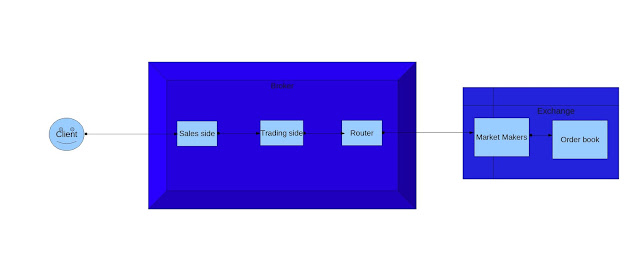- Sales desk: which enables the clients to send orders, mainly. At this point, the order is converted to a form that the broker systems can understand.
- Trading Desk: which is responsible for actually working upon these orders strategically, using some algorithms like TWAP, VWAP etc before sending them to the exchange.
- Order routers: which act like an exit point, for the orders, from the brokerage house to the exchange. These routers have knowledge of multiple exchange and may route to the exchange where the order will get best possible execution prices.
Although this traditional model works great for retail clients, there are some big hedge funds, single huge institutional investors who need more than this. These clients are sophisticated clients having their own expertise in all respects - infrastructure as well as traders. They don't need any extra services provided by the broker. They prefer to use trading strategies, slice-and-dice orders as per their own expertise. So, in such a scenario, all they need from the brokers is for them to provide these clients with exchange connectivity. So, the above flow now looks something like -
This is what we call Direct Market Access (DMA) flow.
There are two kinds of DMA's mainly:
- In the first type, the client has his own expertise. However, he still needs to use the order router service of the clearing member (basically broker) which then routes his orders to different exchanges. This was the first step towards DMA and removing the "call by phone and place order" stage. Thus, in this stage, orders still go through the market makers before entering into the order books.
- In the second type, the client, in true sense, needs only exchange connectivity from the broker. For this purpose, the brokers may provide the client with a platform which has global connectivity across exchanges in the world. This platform is deployed on the client end rather than working on the broker side. Examples of such a platform are Morgan Stanley's Passport, Goldman Sachs' REDIPlus etc. These tools allow clients to place orders which will directly be entered into the exchanges order books. This is DMA in its true sense! Its as shown in the diagram above by the rounded arrow flow.
- Self expertise: The clients can rely on their own expertise rather than using some brokers services. This enables them to build custom strategies suited for their firm while trading. They can synthesize orders as they like. they also have their own infrastructure . All this saves them the cost of equivalent services provided by the broker.
- Lesser commisions per trade, since they no longer use broker services, but their own internal expertise.
- Ability to quote their own prices. Normally, they way it works is, the clients may quote their own prices. The market makers quote the prices they can offer to the brokers. The brokers in turn can offer only these prices to the clients. However, with DMA, since we skip the market makers, the clients are free to place their own prices on limit orders as they want.
- Faster time to processing. Since DMA enables clients to enter orders directly into the order books, it saves the time of going through all the intermediaries which in the normal case take more time.
- Ability to capture arbitrage opportunities due to high speed.
- Visibility: in the normal case, the market makers may choose to show only some orders on the order book and not show some. However, with DMA, clients are guaranteed that all their orders can be seen by everyone on the market. This enables faster executions.
- Ability to capture high liquidity pools.






No comments:
Post a Comment